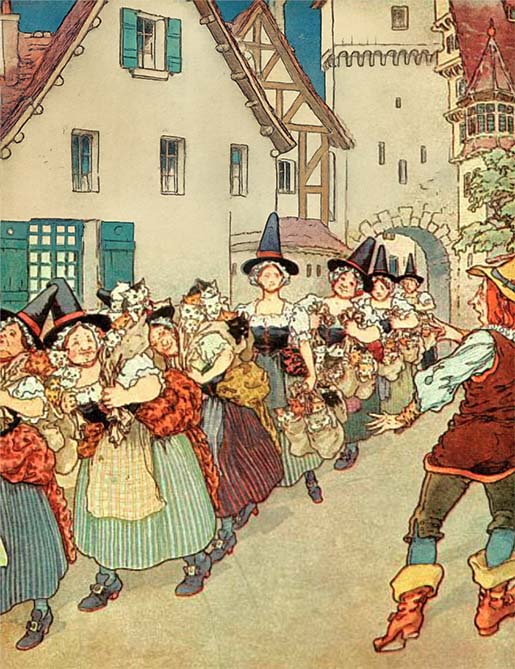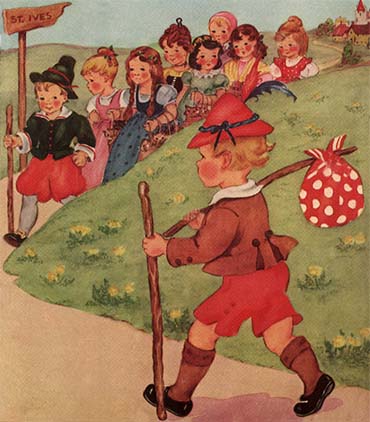As I Was Going to St. Ives
As I was going to St. Ives
I met seven wives.
Every wife had seven sacks,
Every sack had seven cats,
Every cat had seven kits.
Kits, cats, sacks and wives,
How many were going to St. Ives?

Origins
This riddle has been tripping people up for at least three centuries. A manuscript from around 1730 gives an early version with nine wives, nine sacks, nine cats, and nine kittens. By 1779 a form essentially like today’s was printed in a popular magazine, and the modern “seven wives” wording settled in soon after. Early printings sometimes skip the phrase “a man with,” which is why you’ll see both “I met seven wives” and “I met a man with seven wives” in older books.
Which St. Ives? England has two famous ones—Cornwall (a fishing port) and Cambridgeshire (an old market town). Both have claimed the honor. There’s no definitive proof either way, which suits a riddle that thrives on ambiguity.
Meaning (and the trick)
Most people start multiplying. Seven wives × seven sacks × seven cats × seven kits = 2,401 kits, plus the cats, sacks, wives, the man, and the narrator—2,802 in total—if they were all headed the same way.
But that’s the trap. The speaker says, “As I was going to St. Ives, I met …” Traditionally the answer is one: only the narrator is confirmed to be going there. Everyone else is simply encountered on the road.
That said, the riddle has always invited debate. Maybe they really were all bound for the same town. Maybe some were being carried (old replies even joke that only eight could walk; the rest were “carried”). The fun is in the wording—and in how confidently people do the wrong math.
Variants
-
The “nine” version. Earliest forms use nine wives, nine sacks, and so on. The structure is the same; the numbers just scale up.
-
With or without “a man.” Some versions say, “I met seven wives,” others, “I met a man with seven wives.” By the 1800s the “man with” phrasing was widespread.
-
Short forms. Chapbooks often printed only the opening lines and the final question, trusting listeners to supply the logic (or the misstep).
-
Classroom twists. Modern collections add follow-up puzzles (“How many legs were walking?” “How many living creatures?”) to push students past rote multiplication into careful reading.
 This is a nursery rhyme that doubled as a parlor puzzle. It lived both in children’s books and in the adult world of magazines and coffee-house banter. The cadence makes it easy to remember; the ambiguity makes it good sport. It also fits a long tradition of English riddles that hide the answer in plain sight with a single pivot word—here, met.
This is a nursery rhyme that doubled as a parlor puzzle. It lived both in children’s books and in the adult world of magazines and coffee-house banter. The cadence makes it easy to remember; the ambiguity makes it good sport. It also fits a long tradition of English riddles that hide the answer in plain sight with a single pivot word—here, met.
The cat detail feels practical, too. In busy ports and granaries, cats mattered. Cornwall’s St. Ives once needed a lot of them to keep rats off nets and grain; Cambridgeshire’s St. Ives sat on old trading routes. Either town makes sense as a stage for a traveling narrator and an unlikely procession.

